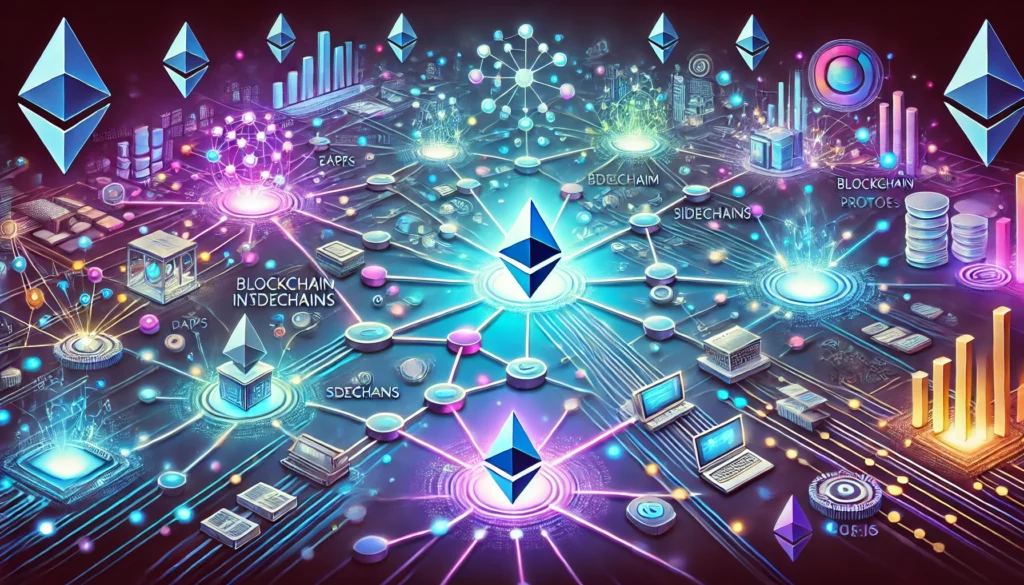The blockchain ecosystem has grown significantly over the past decade, with thousands of blockchain networks emerging, each designed with specific use cases, consensus mechanisms, and technological innovations. While this diversity has driven innovation and expanded the potential applications of blockchain technology, it has also led to a fragmented landscape where different blockchains operate in isolation, unable to communicate or interact with each other. This lack of interoperability has been one of the key challenges hindering the full potential of blockchain technology and decentralized applications (dApps).
To address this issue, blockchain interoperability has become a hot topic, with developers and blockchain projects working on cross-chain solutions to enable different blockchain networks to communicate, share data, and conduct transactions seamlessly. Cross-chain solutions are a critical component of the next phase of blockchain development, allowing different blockchain ecosystems to interoperate, thereby unlocking new opportunities for decentralized finance (DeFi), enterprise adoption, and broader blockchain usage.
In this article, we will explore the concept of blockchain interoperability, the importance of cross-chain solutions, and how various technologies and projects are working to bridge the gap between isolated blockchain networks.
1. The Challenge of Blockchain Fragmentation
The blockchain space is highly diverse, with different networks being built for specific purposes. Some, like Bitcoin and Litecoin, focus on peer-to-peer value transfer and store of value, while others, like Ethereum and Solana, enable decentralized applications and smart contracts. The Ethereum network, for example, has a vibrant ecosystem of decentralized finance (DeFi) applications, while Polkadot is designed to facilitate multi-chain interoperability and governance.
Despite the rapid expansion and growth of these networks, blockchain interoperability has remained a significant challenge. Each blockchain operates independently, with its own set of protocols, consensus mechanisms, and token standards. This creates a siloed environment where assets, data, and applications on one blockchain cannot easily interact with those on another. In essence, while these blockchains are powerful and innovative in their own right, their inability to communicate with one another limits the potential of the broader blockchain ecosystem.
For example, if an individual wants to transfer an asset from Ethereum to Binance Smart Chain (BSC), they would need to use a centralized exchange or rely on third-party intermediaries. These solutions are cumbersome, time-consuming, and often involve additional risks, particularly in the context of trust and security.
2. What is Blockchain Interoperability?
Blockchain interoperability refers to the ability of different blockchain networks to communicate and exchange data, assets, and value in a seamless and secure manner. It allows users to transfer assets and information between different blockchains without needing centralized intermediaries or converters. This is an essential requirement for the widespread adoption of blockchain technology, especially as businesses and financial institutions look to leverage multiple blockchain networks for their operations.
In the context of DeFi, interoperability allows assets and liquidity to flow between different blockchain ecosystems, creating a more efficient and interconnected decentralized financial system. By enabling cross-chain compatibility, different blockchain platforms can pool resources, increase liquidity, and provide users with a wider range of services and opportunities.
For example, a DeFi user could easily transfer tokens between Ethereum, BSC, and Polygon without relying on centralized exchanges or wrapping tokens. This interoperability expands the potential for cross-platform applications, enhances market efficiency, and creates more opportunities for blockchain-based innovation.
3. The Role of Cross-Chain Solutions in Blockchain Interoperability
Cross-chain solutions are designed to solve the fragmentation issue by allowing different blockchain networks to interact and share information. These solutions typically use technologies such as atomic swaps, sidechains, bridges, and interoperability protocols to facilitate cross-chain transactions and data exchange.
3.1 Atomic Swaps
An atomic swap is a technology that allows users to exchange cryptocurrencies from two different blockchains without the need for a trusted intermediary. This process is facilitated by smart contracts, which ensure that the trade only occurs if both parties fulfill the terms of the agreement. Atomic swaps are designed to be secure and fast, enabling direct transfers between different blockchain ecosystems.
For example, a user could swap Bitcoin for Ethereum through an atomic swap, without relying on a centralized exchange. Atomic swaps are a powerful solution for enabling cross-chain asset exchanges and reducing the need for intermediaries in blockchain transactions.
3.2 Sidechains
A sidechain is a separate blockchain that is attached to a main blockchain (the parent chain) and allows for the transfer of assets between the two. Sidechains can be customized to meet specific requirements such as scalability, privacy, or compatibility with other blockchains. They enable interoperability by creating bridges between different blockchain ecosystems.
For instance, the Polygon network operates as a sidechain to Ethereum, providing faster and cheaper transactions while maintaining compatibility with Ethereum’s assets and decentralized applications (dApps). Sidechains enable a high degree of flexibility and scalability, allowing assets to move freely between chains.
3.3 Bridges
A blockchain bridge is a mechanism that allows for the transfer of assets and data between two different blockchains. Bridges can enable the transfer of tokens, smart contracts, and other assets between chains, enhancing liquidity and interoperability. Blockchain bridges act as the intermediary between blockchains, facilitating the secure transfer of assets and data.
For example, the Wormhole bridge enables cross-chain transactions between Solana, Ethereum, and other blockchains. These bridges provide a seamless way for users to transfer assets from one blockchain to another without the need for centralized intermediaries, improving the liquidity and efficiency of decentralized applications.
3.4 Interoperability Protocols
Several protocols have been developed specifically to address blockchain interoperability. These protocols aim to create a standardized framework that allows blockchains to communicate with each other without compromising security or decentralization. Some well-known interoperability protocols include:
- Polkadot: Polkadot enables different blockchains, called parachains, to communicate and share information through a shared network. Polkadot’s interoperability protocol allows blockchains to transfer assets and data without centralization or fragmentation.
- Cosmos: Cosmos offers the Inter-Blockchain Communication (IBC) protocol, which connects different blockchains to create an ecosystem of interoperable networks. The IBC protocol enables the transfer of assets and data between blockchains, enabling users to move assets freely across the Cosmos network.
4. Advantages of Blockchain Interoperability
Blockchain interoperability opens up numerous advantages for users, developers, and enterprises:
4.1 Increased Liquidity and Market Efficiency
With interoperability, users can move assets freely between different blockchains, thereby enhancing liquidity across multiple platforms. This increases the market’s overall efficiency, allowing for better price discovery and more dynamic decentralized exchanges (DEXs). For example, DeFi platforms can aggregate liquidity from multiple blockchains, improving trading volumes and market depth.
4.2 Broader Use Cases and Cross-Chain dApps
Interoperability enables the development of cross-chain decentralized applications (dApps). These applications can run on multiple blockchains and utilize the strengths of different ecosystems, making them more versatile and appealing to a larger audience. Cross-chain dApps open up new opportunities for developers to create applications that take advantage of various blockchain networks’ features, such as speed, scalability, privacy, and security.
4.3 Enhanced User Experience
Users benefit from interoperability by having greater flexibility and more options for managing their assets. Instead of being confined to one blockchain ecosystem, users can freely move between networks, take advantage of lower fees, or access different features offered by each blockchain.
5. Challenges to Blockchain Interoperability
Despite the significant progress made in cross-chain solutions, there are still several challenges to achieving full blockchain interoperability:
5.1 Security Concerns
Interoperability increases the complexity of blockchain networks, which can create security risks. Bridges and sidechains are particularly vulnerable to hacks and exploits, as they often involve the transfer of assets across networks with different security protocols. If one chain is compromised, the entire network may be at risk.
5.2 Standardization Issues
Currently, there is no universally accepted standard for interoperability between blockchains. Each blockchain has its own protocol, and creating standardized communication methods between them is a complex task. For interoperability to succeed on a larger scale, the industry will need to adopt common standards for cross-chain transactions, which could take time.
5.3 Scalability
Cross-chain solutions need to be highly scalable in order to support the growing number of blockchains and dApps. Ensuring that transactions between blockchains are processed quickly and efficiently without compromising security is a critical challenge for developers.
6. Conclusion on Blockchain Interoperability
Blockchain interoperability is a critical step toward realizing the full potential of decentralized networks. As cross-chain solutions like bridges, sidechains, and interoperability protocols continue to develop, the blockchain ecosystem will become more connected and efficient, paving the way for more innovative applications and use cases. These solutions promise to unlock new opportunities in decentralized finance, cross-chain dApps, and multi-chain ecosystems, driving adoption and creating a more seamless user experience.
While challenges remain, the future of blockchain interoperability is promising, and ongoing developments will continue to bridge the gap between fragmented blockchain networks, creating a more integrated and unified decentralized world.


